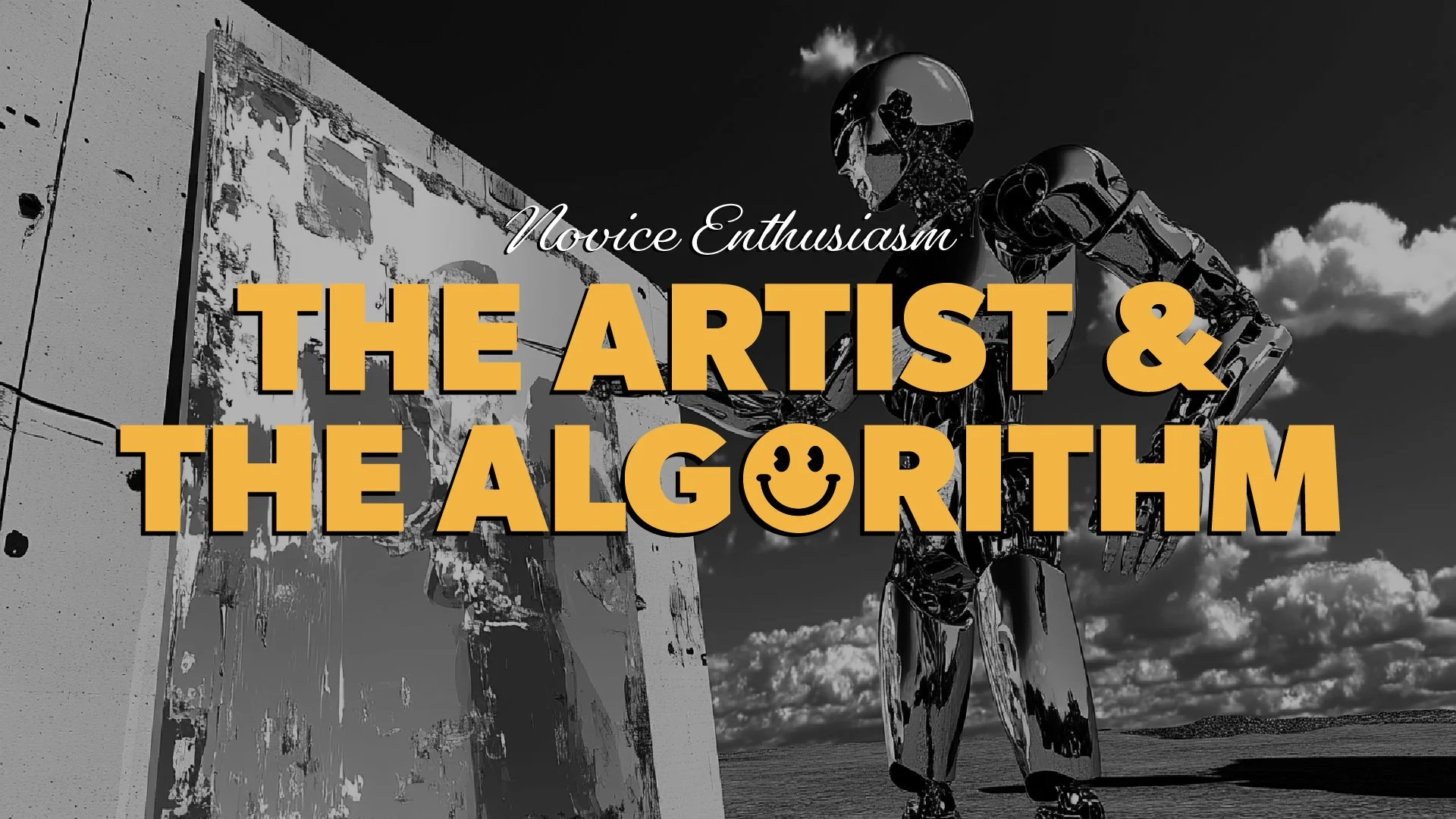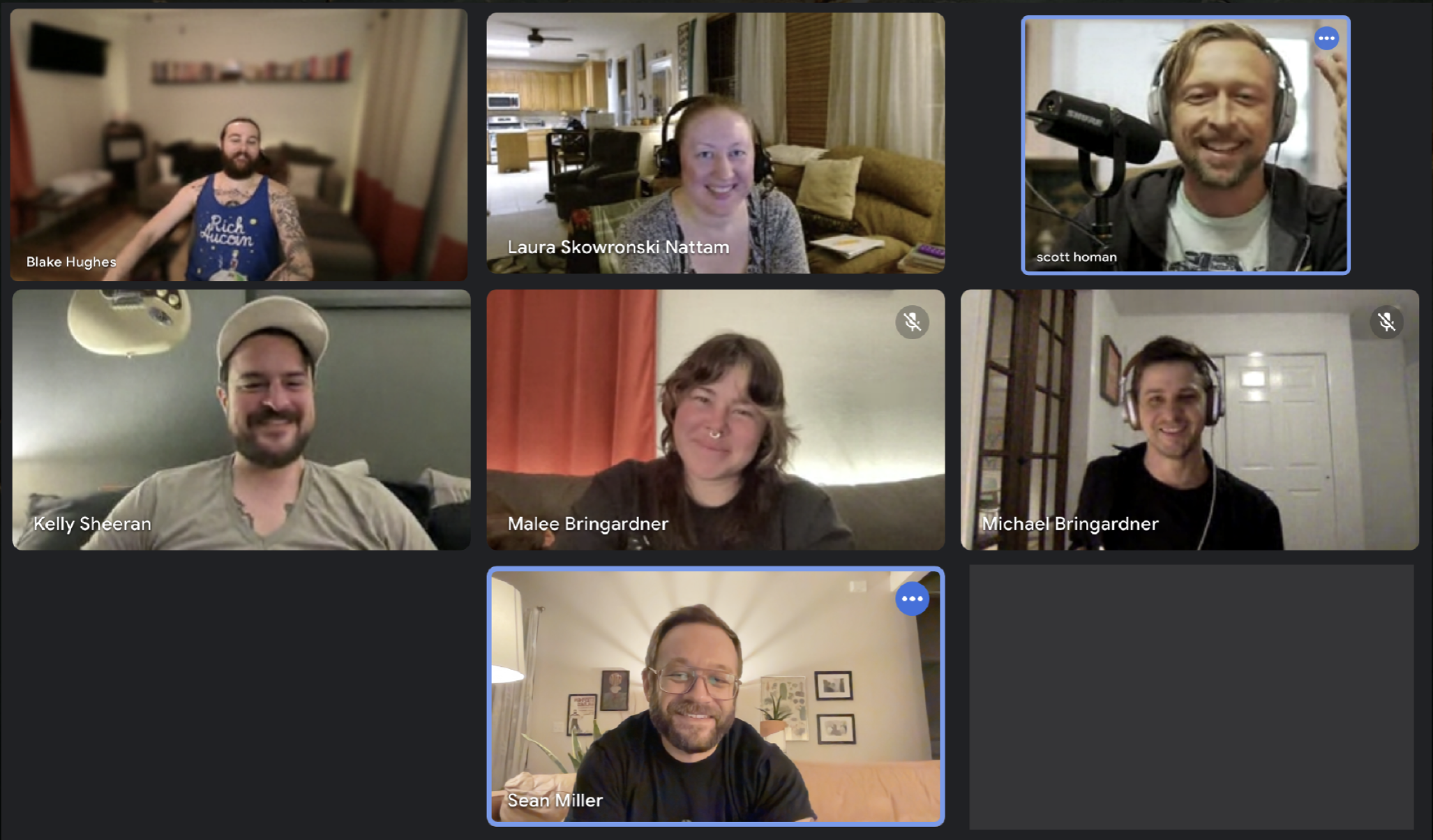Novice Enthusiasm: The Artist & The Algorithm
A Novice Enthusiasm reflection on AI, craft, and the refusal to quit.
I Remember My First Time…
The first time I encountered generative AI, I was scrolling through X and saw a handful of early MidJourney renderings. Most were crap, but some were visually rich, cinematic, and detailed in a way that made me uncomfortable. I immediately thought, “Oh shit, this is gonna put me out of a job”.
Years of honing my craft until my hands felt like they had early onset arthritis and sacrificing sleep to get incrementally better, suddenly seemed irrelevant. Now, with a half-baked sentence and an internet connection, someone could spit out something that looked like the work I had been bleeding for.
The moment I saw what a person could produce with a few words, I knew there was no point fighting it. Corporate America was going to treat this like it treats everything else that promises efficiency and shoehorn it into every workflow possible. This genie was never going back into the bottle.
As an art director, I also knew this wasn’t just about me. It was about how teams would eventually be asked to work with these tools, whether they were ready or not. For example, the first time I was asked to train an in-house generative AI model for a gaming company I was working for, there was zero discussion about my thoughts on whether or not we should use it. Without ever saying it explicitly, I got the distinct feeling that the company stance was, “Fuck your feelings. Fuck your ethics. Faster production means more money. If you aren’t comfortable using this, we’ll find someone who is”. Honestly, if it came down to a less experienced artist being brought in to replace me, well… I wasn’t gonna let that happen. I gotta eat.
So I learned it immediately. Not because I was thrilled about it, but because pretending it wasn’t happening felt like career suicide. In this economy, the “purist” position is often indistinguishable from unemployment.
Who Is This For?
Watching people use MidJourney in those early days was oddly comforting. The fear drained a little with every image I saw flood the Discord since most of it was complete garbage. Someone with zero artistic experience could now make their mashup dreams of Goku wearing a Superman costume while holding a lightsaber come true.
It reminded me of my years in Artist Alley at comic book conventions. I’d be there struggling to sell a stack of $5 comics I wrote, drew, and published myself, while the guy at the next table sold crudely drawn, outrageously busty anime women in suggestive poses on printer paper. He walked away with hundreds in cash at the end of all three days of the convention.
Apparently, this is what people really wanted. Not story. Not perspective. Just quick, disposable dopamine designed for their personal spank bank. Years later, Midjourney proved it. Generative AI had just automated the “scantily clad anthropomorphic Pikachu making out with Sonic the Hedgehog” commission. And for a lot of people, that was art enough.
I wondered, “Is this really the best we can come up with when handed one of the most powerful creative tools ever invented?”
For me, though, it reinforced something I’d learned from years of design and production: most output is noise. The real work is knowing how to filter it, frame it, and build something people actually want to connect with.
So Why Bother?
Because art isn’t about the tool. It’s about the why. It’s personal expression of what matters to you. It’s the sharing of perspective. It’s the building of connection through story.
Once I came back to that truth, the fear lost its grip. I wasn’t in danger of being replaced by a prompt, because what mattered wasn’t my ability to make something pretty, it was my ability to say something worth hearing.
Yes, I use MidJourney now. At the risk of sounding like I’ve apostatized from my artistic community, I’ll say it plainly: generative AI is a useful tool. But it has a ceiling called “the human experience,” and no matter how sophisticated it gets, that ceiling isn’t going anywhere. Sure, art can be used for self-indulgent gratification, or as a means of keeping oneself entertained, but without context, without story, without the human element, it will always be hollow.
In production terms, AI can sketch the walls, but it can’t build the house. That requires people who know what the house is for in the first place.
Life Happened. AI Kept Up.
I didn’t find MidJourney during a time of stability. I found it in the middle of my own personal demolition:
A divorce I didn’t see coming.
Being cut off from my friends, family, and entire way of life after leaving a high-control religion (aka a cult).
Two job losses in a row.
Three kids to take care of.
Selling my home to survive.
In the middle of all that, a story came to me. It was clear, urgent, and bigger than anything I’d worked on before. But my ideas were moving faster than my hands could draw, and the speed of my changing circumstances was threatening to bury them altogether.
MidJourney was a stopgap. It allowed me to keep my story alive when I didn’t have the bandwidth to fully render it by hand. It wasn’t replacing my art. It was buying me time. In a production setting, half the battle is keeping momentum when conditions aren’t ideal.
Exhibit A
Take Kintsugi. It’s the most personal project I’ve ever worked on, and while I’m not going to spill the details here, I’ll say this, the early AI visuals I generated weren’t the art itself. They were just the quick visual placeholders that let me work out tone, atmosphere, and rhythm before I put my own lines down.
Those rough images gave me something tangible I could share with collaborators they could react to. They kept the momentum alive long enough for me to deepen the work, find the emotional hook, and build a team around the story.
Team Kintsugi
That’s what I’ve found again and again in production and visual storytelling. Early scaffolding, whether through sketch, moodboard, or AI, gives teams something to align around. It’s not the finished piece. It’s the catalyst that moves people toward it.
The Audacity
The title of this post isn’t an accident.
There’s an audacity in corporate America that feels like performance art. The sheer gall to introduce a technology like AI, not as a collaborative tool, but as a way to squeeze more output from fewer humans while insisting it’s “empowering creators” is the giveaway. It’s the business equivalent of telling someone you love them for who they are, and then punishing them for the reasons you told them they were special. Trust me. I grew up in a cult. It’s the same shit.
And yet, there’s also an audacity in the creative community. A stubborn refusal to quit, even when the message from the culture is clear: We don’t care about you, we just want what you produce. We keep going anyway. We keep showing up. The real audacity is continuing to make meaningful art in a world that treats it as an afterthought.
AI’s Ceiling
The more I played with generative AI, the more I realized its limit. It can’t make anything worth caring about without you. It’ll sure try though. Honestly, it can produce some really impressive stuff, but it’s always in imitation of the real thing.
It can come close to technical perfection. It can be visually stimulating to the point of overwhelm. It can come up with surprising combinations. But without the lived experience, the scars, the love, the point of view, it’s just surface. Beautiful noise.
Yeah, some in the creative industry will use it to skip the years of practice it takes to actually get good at something. It’s my belief that reliance on AI to do your work for you is the hight of laziness and contributes to societal gluttony. Historically, these two traits have never lead to truly impactful creative work and if you choose to use AI in your work like I have, its your responsibility to humanity at large to not let your creative muscles and artistic spirit atrophy. You’ll end up with work that’s weak, ultimately flavorless, and of no benefit to anyone.
The Responsibility
A tool can make something for you, but it can’t make something about you. That’s your job, not just as an artist, but as a human with a pulse and a perspective. It’s the part no algorithm can automate, no matter how many parameters it processes.
Generative AI is seductive because it gives you the illusion of mastery without the years of midnight work, bad drawings, failed experiments, and small humiliations that forge an actual artistic voice. In my opinion, skip that process, and you never develop a creative perspective that is truly yours.
The responsibility of connection through art, especially story, rests on our shoulders. It always has. It’s the thing that makes someone stop scrolling, lean in, see you, and feel seen. It’s based on something you lived, wrestle with, and then translate into a form worth sharing.
And here’s the truth: if you’re an artist in 2025, you don’t have the luxury of ignoring this technology. Personally, I think the days of the experienced tactical artist, someone hired for their skill, not their perspective, are numbered. If you don’t believe me and you’re a freelancer currently looking for work, prove me wrong.
It’s my belief that in the age of AI, we need missionaries, not mercenaries. Missionaries are driven by belief, not quarterly earnings. If you are using AI to get work, cool. Good on ya. Just remember the line between using AI and letting it use you is thinner than you think. Cross it, and you’ll lose the one thing that makes you irreplaceable: your voice.
Use it if you must. Use it to keep pace with your imagination. Use it to help your ideas survive the chaos of life. But never let it define the limits of what you have to say, because if a picture is worth a thousand words, make sure yours can’t be mistaken for anyone else’s.
That’s part of what responsible creativity looks like. It includes the stubborn belief that your story matters enough to tell, again and again, with whatever tools are at hand, without ever letting the tool become the story.
Remember, if you won’t fight for your voice, the algorithm will be happy to take it from you.
About the Author
Sean Miller is a visual designer, illustrator, and storyteller with over a decade of experience in games, comics, and branding. He has led creative production for companies like Zynga, Yuga Labs, and Sephora, and co-created original IP in both publishing and gaming.
He is the creator of Novice Enthusiasm, a creative philosophy that champions curiosity, empathy, and story over perfectionism. His approach helps teams cut through noise, align around vision, and move quickly from concept to production without losing the human element that makes art connect.
If you’re looking for someone who can bring clarity, visual direction, and story-driven focus to your team, Sean is available for consulting and creative leadership.






